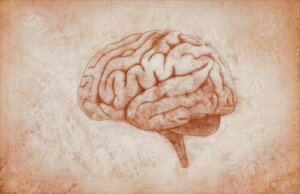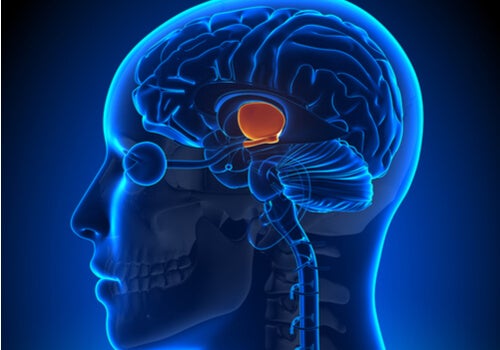The Diencephalon: Structure, Functions, and Curiosities

The central nervous system (CNS) is divided into two parts: the encephalon and the spinal cord. The encephalon is the part that’s furthest back in the skull and contains one of the main brain structures: the diencephalon.
This structure is involved in the control of affective behavior, the regulation of consciousness, the autonomic nervous system, sleep, and other factors. Let’s delve a little deeper into this.
The diencephalon: what is it?
The diencephalon develops in the area of the prosencephalon or forebrain. This is the most frontal part of the brain at the beginning of embryonic development. As the prosencephalon grows, it divides into the diencephalon and the telencephalon. At this point, it becomes a bridge between the midbrain and the telencephalon.
It’s located below the corpus callosum and the fornix, and is joined on the sides with the hemispheres of the telencephalon. Thus, as we can see, it’s located in the middle part of the brain.
The structures of the diencephalon are connected to the rest of the nervous system, including the cortical and subcortical areas. Therefore, it’s a central area that sends and receives nerve signals (afferences and efferences, respectively). Thus, it has a fundamental role in the proper functioning of multiple biological processes.

The structure and functions of the diencephalon
The diencephalon consists of four main structures, and we’ll list them now:
Epithalamus
- Structure. The epithalamus contains the pineal gland or epiphysis, the nuclei of the habenula, the thalamic medullary stria, the posterior white commissure, the habenular commissure, the lamina tectoria, and the choroidal plexuses.
- Functions. It regulates circadian rhythms of hormonal secretions, mainly linked with light and dark cycles. Also, it influences the gonadal sphere (testicles and ovaries) and, moreover, is in charge of secreting melatonin.
Thalamus
- Structure. It consists of the anterior thalamus, medial thalamus, and lateral thalamus. The latter, in turn, contains a dorsal region, a ventral region, and the metatallamus.
- Function. It works as a relay between the cortical and subcortical connections. It’s a receptor for the sensory afferences, except for the olfactory ones which reach directly the cortex. In addition, it intervenes in the regulation of consciousness and the sleep cycle.
Subthalamus
- Structure. This structure contains the subthalamic nucleus of Luys, the zone of uncertainty, the prerrupal field of Forel, the pale globe, and the compact dorsal, and the ventral reticular portions of the substantia nigra (black substance).
- Functions. It participates in the regulation of movements. In addition, it’s related to the production of dopamine and, therefore, to the brain’s reward system.
Hypothalamus
- Structure. From front to back, it divides into the anterior, middle, and posterior hypothalamus. It contains a periventricular, medial, and lateral area.
- Functions. It’s the regulatory center of the visceral functions working through the vegetative and endocrine systems. In addition, it regulates emotional behavior through the limbic system, maintains homeostasis, and produces the vasopressin and oxytocin hormones.
In addition to these structures, the diencephalon has a cavity, called the third ventricle, located below the thalamus. This ventricle allows the circulation of the cerebrospinal fluid and helps maintain the shape and structure of the brain while allowing it to stay healthy.

Fun facts about the diencephalon
The diencephalon is the control center that helps our body maintain its internal balance or homeostasis. Here are some fascinating facts about it:
- It only represents two percent of the total weight of the nervous system.
- The pituitary, which is attached to the hypothalamus, intervenes in processes such as reproduction and growth through the action of hormones.
- It maintains body temperature.
- It regulates appetite and, therefore, food intake.
- The habenula, part of the epithalamus, is related to fear and depression.
- It regulates the endocrine activity of the adenohypophysis.
- It’s the main modulator in the functioning of the autonomic nervous system (ANS) – formerly the vegetative nervous system.
The diencephalon, stress, and emotions
The diencephalon also participates in neuroendocrine responses to stress. In fact, the journal Dialogues in Clinical Neuroscience published a study about the relationship between the hypothalamus-pituitary-adrenal axis and stress. In it, they postulate that animals, in order to respond to stress, activate a range of physiological and behavioral responses associated with this axis.
The authors define stress as a state of real or perceived threat. Given that the hypothalamus regulates homeostasis, it’s in charge of managing the situation and working with the nervous, endocrine, and immune systems.
Likewise, experts have demonstrated the enormous importance of the hypothalamus in the creation of emotional behavior. For example, H. Nakao, in a study published in the American Journal of Physiology, proved that stimulation of the hypothalamus in cats through implanted electrodes led to aggressive responses.
Thanks to the diencephalon, a very little known “great administrator”, communication between the cortical and subcortical levels is possible. Also, it allows us to maintain a correct balance in our bodies and to regulate our emotions, always hand in hand with other systems. A control center as wonderful as it is effective.
All cited sources were thoroughly reviewed by our team to ensure their quality, reliability, currency, and validity. The bibliography of this article was considered reliable and of academic or scientific accuracy.
- Bear, M. F. Connors, B. W., Paradiso, M.A., Nuin, X. U., Guillén, X. V. & Sol Jaquotot, M. J. (2008). Neurociencias: la exploración del cerebro. Wolters Kluwer/Lippincott Williams & Wikins.
- Nakao, H. (1958). Emotional behavior produced by hupothalamic stimulation. American Journal of Physiology, 19 (2), pp. 411-418.
- Smith, S. M., & Vale, W. W. (2006). The role of hypothalamic-pituitary-adrenal axis in neuroendocrine responses to estress. Dialogues in clinical neuroscience, 8 (4), pp. 383.
This text is provided for informational purposes only and does not replace consultation with a professional. If in doubt, consult your specialist.








